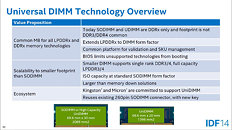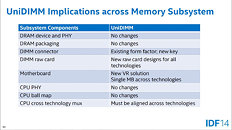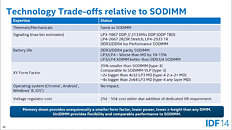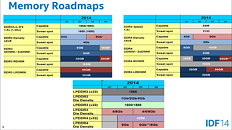- Joined
- Oct 9, 2007
- Messages
- 47,677 (7.43/day)
- Location
- Dublin, Ireland
| System Name | RBMK-1000 |
|---|---|
| Processor | AMD Ryzen 7 5700G |
| Motherboard | Gigabyte B550 AORUS Elite V2 |
| Cooling | DeepCool Gammax L240 V2 |
| Memory | 2x 16GB DDR4-3200 |
| Video Card(s) | Galax RTX 4070 Ti EX |
| Storage | Samsung 990 1TB |
| Display(s) | BenQ 1440p 60 Hz 27-inch |
| Case | Corsair Carbide 100R |
| Audio Device(s) | ASUS SupremeFX S1220A |
| Power Supply | Cooler Master MWE Gold 650W |
| Mouse | ASUS ROG Strix Impact |
| Keyboard | Gamdias Hermes E2 |
| Software | Windows 11 Pro |
The transition between DDR2 and DDR3 system memory types was slower than the one between DDR and DDR2. DDR3 made its mainstream debut with Intel's X38 and P35 Express platforms, at a time when the memory controller was still within the domain of a motherboard chipset, at least in Intel's case. The P35 supported both DDR2 and DDR3 memory types, and motherboard manufacturers made high-end products based on each of the two memory types, with some even supporting both.
Higher module prices posed a real, and higher latencies, posed a less real set of drawbacks to the initial adoption of DDR3. Those, coupled with the limited system bus bandwidth, to take advantage of DDR3. DDR3 only really took off with Nehalem, Intel's first processor with an integrated memory controller (IMC). An IMC, again in Intel's case, meant that the CPU came with memory I/O pins, and could only support one memory type - DDR3. Since then, DDR3 proliferated to the mainstream. Will the story repeat itself during the transition between DDR3 and the new DDR4 memory introduced alongside Intel's Core i7 "Haswell-E" HEDT platform? Not exactly.




Intel wants to make real sure that the swelling inventories of DDR3 memory modules are sufficiently digested by the market (sold out), before imposing DDR4 onto the mainstream. Hence the memory made its grand client entrance with Core i7 "Haswell-E," a family of processors that starts at $390, going all the way up to $1000. The target audience of these chips won't mind spending the extra dime on cutting-edge technologies, including memory. "Haswell-E" features a 256-bit wide DDR4 IMC, which at JEDEC standard speeds of DDR4-2133 MHz, can bathe the processor's 6-8 cores in 68 GB/s of memory bandwidth, right off the bat. DDR4 brings energy efficiency to the table. DDR4-2133 MHz modules ship with rated voltage as low as 1.2V, compared to the 1.8V DDR3 debuted with, before dropping to 1.65V on Nehalem, and 1.5V on SandyBridge. These drops in module voltages were made possible with DRAM manufacturers shrinking their fab process nodes.
Intel's bright idea about transitioning between DDR3 and DDR4 for mainstream client platforms is not hugely different from how its P35 Express chipset dealt with the issue. It plans to come up with a new memory module form-factor, called UniDIMM. It's a DIMM that can hold both DDR3-class and DDR4-class DRAM chips, designed for Intel's upcoming Core "Skylake" processors. "Skylake" will feature an IMC that supports both DDR3 and DDR4. With UniDIMM at their disposal, system manufacturers can source UniDIMM modules with DDR3 DRAM chips (which will be cheap, until DDR3 inventories begin drying up), and offer upgrade potential to UniDIMMs with DDR4 chips (which will get progressively cheaper). Future notebooks that ship with DDR4-UniDIMM memory will still support older DDR3-UniDIMM.
Capiche? No? UniDIMM is a standardized module design, with its key cutout notch at a certain point. Measuring 69.6 mm x 20 mm, it's as wide, but shorter than an SO-DIMM. There will be two kinds of UniDIMMs, DDR3 UniDIMM and DDR4 UniDIMM, both having 260 pins, the same key position (but one that's different from DDR3 SO-DIMM), and hence work on a platform that supports both standards, "Skylake," in this case. The module will be designed to support both standard- and LP- DDR3 and DDR4 DRAM chips.
DDR3/LPDDR3 UniDIMMs will ship with frequencies of 1866 MHz (DDR) as standard. DDR4/LPDDR4 ones will start at 2666 MHz (Skylake's standard DDR4 memory clock speed, double that of DDR3-1333, which was Lynnfield's standard). There will be higher-tier standardized clocks, such as 2133 MHz for DDR3/LPDDR3, and 2933 MHz for DDR4/LPDDR4. Since UniDIMM is more of Intel's pet-project than that of JEDEC, it gets to announce which memory module makers have expressed interest in it - Kingston and Micron (makers of Crucial) have expressed commitment to it.
"Skylake" Core processors come out in 2015. That's going to be when DDR4 enters mainstream client platforms.
View at TechPowerUp Main Site
Higher module prices posed a real, and higher latencies, posed a less real set of drawbacks to the initial adoption of DDR3. Those, coupled with the limited system bus bandwidth, to take advantage of DDR3. DDR3 only really took off with Nehalem, Intel's first processor with an integrated memory controller (IMC). An IMC, again in Intel's case, meant that the CPU came with memory I/O pins, and could only support one memory type - DDR3. Since then, DDR3 proliferated to the mainstream. Will the story repeat itself during the transition between DDR3 and the new DDR4 memory introduced alongside Intel's Core i7 "Haswell-E" HEDT platform? Not exactly.




Intel wants to make real sure that the swelling inventories of DDR3 memory modules are sufficiently digested by the market (sold out), before imposing DDR4 onto the mainstream. Hence the memory made its grand client entrance with Core i7 "Haswell-E," a family of processors that starts at $390, going all the way up to $1000. The target audience of these chips won't mind spending the extra dime on cutting-edge technologies, including memory. "Haswell-E" features a 256-bit wide DDR4 IMC, which at JEDEC standard speeds of DDR4-2133 MHz, can bathe the processor's 6-8 cores in 68 GB/s of memory bandwidth, right off the bat. DDR4 brings energy efficiency to the table. DDR4-2133 MHz modules ship with rated voltage as low as 1.2V, compared to the 1.8V DDR3 debuted with, before dropping to 1.65V on Nehalem, and 1.5V on SandyBridge. These drops in module voltages were made possible with DRAM manufacturers shrinking their fab process nodes.
Intel's bright idea about transitioning between DDR3 and DDR4 for mainstream client platforms is not hugely different from how its P35 Express chipset dealt with the issue. It plans to come up with a new memory module form-factor, called UniDIMM. It's a DIMM that can hold both DDR3-class and DDR4-class DRAM chips, designed for Intel's upcoming Core "Skylake" processors. "Skylake" will feature an IMC that supports both DDR3 and DDR4. With UniDIMM at their disposal, system manufacturers can source UniDIMM modules with DDR3 DRAM chips (which will be cheap, until DDR3 inventories begin drying up), and offer upgrade potential to UniDIMMs with DDR4 chips (which will get progressively cheaper). Future notebooks that ship with DDR4-UniDIMM memory will still support older DDR3-UniDIMM.
Capiche? No? UniDIMM is a standardized module design, with its key cutout notch at a certain point. Measuring 69.6 mm x 20 mm, it's as wide, but shorter than an SO-DIMM. There will be two kinds of UniDIMMs, DDR3 UniDIMM and DDR4 UniDIMM, both having 260 pins, the same key position (but one that's different from DDR3 SO-DIMM), and hence work on a platform that supports both standards, "Skylake," in this case. The module will be designed to support both standard- and LP- DDR3 and DDR4 DRAM chips.
DDR3/LPDDR3 UniDIMMs will ship with frequencies of 1866 MHz (DDR) as standard. DDR4/LPDDR4 ones will start at 2666 MHz (Skylake's standard DDR4 memory clock speed, double that of DDR3-1333, which was Lynnfield's standard). There will be higher-tier standardized clocks, such as 2133 MHz for DDR3/LPDDR3, and 2933 MHz for DDR4/LPDDR4. Since UniDIMM is more of Intel's pet-project than that of JEDEC, it gets to announce which memory module makers have expressed interest in it - Kingston and Micron (makers of Crucial) have expressed commitment to it.
"Skylake" Core processors come out in 2015. That's going to be when DDR4 enters mainstream client platforms.
View at TechPowerUp Main Site


